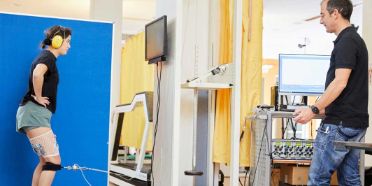Sensorimotor Knee (Part 1 & 2)
Ruptures of the anterior cruciate ligament (ACL) are considered a severe knee injury. Neuromuscular control might change considerably directly after injury occurrence.
Factsheet
- Lead school School of Health Professions
- Institute Physiotherapy
- Research unit Neuromuskuläre Kontrolle
- Funding organisation Others
- Duration 01.01.2016 - 31.12.2018
- Project management Prof. Dr. Heiner Baur
- Head of project Prof. Dr. Heiner Baur
-
Project staff
Prof. Dr. Heiner Baur
Prof. Dr. Angela Blasimann Schwarz - Partner Orthopädie Sonnenhof, Kniechirurgie & Sportverletzungen, Dr. Philipp Henle
- Keywords anterior cruciate ligament, electromyography, neuromuscular control, stretch reflex
Situation
However, there is still no well-founded data on acute changes caused by an ACL injury. The project attempts to close this knowledge gap and investigates reflex and voluntary activation in functional situations in patients right after injury occurrence (max. 3 weeks after).
Course of action
As part of the project, patients with acute ACL ruptures (ACL-D) are compared with healthy controls (ACL-I). The neuromuscular activation of the knee-stabilizing muscles is measured using electromyography in functionally relevant situations. This allows deficits in neuromuscular control to be identified. Surface electromyographic (EMG) activity of the vastus medialis (VM), vastus lateralis (VL), biceps femoris (BF), and semitendinosus (ST) muscles was recorded bilaterally in 15 patients with ACL-D (mean, 13.8 days [range, 7-21 days] since injury) and 15 controls with ACL-I during stair descent and artificially induced anterior tibial translation. The movements of stair descent were divided into preactivity, weight acceptance, and push-off phases. Reflex activity during anterior tibial translation was split into preactivity and short, medium, and late latency responses. Walking on a treadmill was used for submaximal EMG normalization. Kruskal-Wallis test and post hoc analyses with Dunn-Bonferroni correction were used to compare normalized root mean square values for each muscle, limb, movement, and reflex phase between the ACL-D and ACL-I groups.
Result
During the preactivity phase of stair descent, the hamstrings of the involved leg of the ACL-D group showed 33% to 51% less activity compared with the matched leg and contralateral leg of the ACL-I group (P < .05). During the weight acceptance and push-off phases, the VL revealed a significant reduction (approximately 40%) in the involved leg of the ACL-D group compared with the ACL-I group. At short latency, the BF and ST of the involved leg of the ACL-D group showed a significant increase in EMG activity compared with the uninvolved leg of the ACL-I group, by a factor of 2.2 to 4.6.
Looking ahead
Conclusion: In the acute phase after an ACL rupture, neuromuscular alterations were found mainly in the hamstrings of both limbs during stair descent and reflex activity. The potential role of prehabilitation needs to be further studied. (see also: DOI: 10.1177/23259671221123299)

